动词不定式经典用法大全
常见动词不定式词组、句型用法总结

千里之行,始于足下。
常见动词不定式词组、句型用法总结动词不定式是英语语法中的一种形式,由动词原形前加上“to”构成。
动词不定式可以用作名词、形容词或副词,经常用于各种不同的句型和用法。
下面是一些常见的动词不定式词组和句型用法的总结。
1. 动词不定式作主语:例如:To learn a new language is challenging.翻译:学习一种新语言是具有挑战性的。
2. 动词不定式作宾语:例如:I want to go to the beach.翻译:我想去海滩。
3. 动词不定式作形容词的补语:例如:I am happy to help you.翻译:我很兴奋挂念你。
4. 动词不定式用于感官动词后面,表示感受:例如:I saw her cry.翻译:我观察她哭了。
5. 动词不定式用于情态动词后面,表示推想或必要性:例如:He must be busy.翻译:他肯定很忙。
6. 动词不定式用于形容词后面,表示缘由:例如:She was happy to hear the good news.第1页/共3页锲而不舍,金石可镂。
翻译:她听到好消息很兴奋。
7. 动词不定式用于介词后面:例如:I am interested in learning English.翻译:我对学习英语很感爱好。
8. 动词不定式用于短语动词的后面:例如:She wants to give up smoking.翻译:她想戒烟。
9. 动词不定式作定语,修饰名词:例如:He is a person to trust.翻译:他是一个可以信任的人。
10. 动词不定式用于条件句中,表示将来的可能性:例如:If you study hard, you will pass the exam.翻译:假如你努力学习,你会通过考试。
11. 动词不定式用于否定句中,表示不行能或不允许的行为:例如:He refused to eat the vegetables.翻译:他拒绝吃蔬菜。
动词不定式的用法大全

动词不定式的用法大全动词不定式是英语中的一种非谓语动词形式,通常由“to”加上动词原形构成。
它有多种用法,包括以下几个方面:1. 表示目的或意图,动词不定式可以用来表示一个动作或状态发生的目的或意图。
例如,"She studies hard to pass the exam."(她努力学习是为了通过考试。
)。
2. 作为动词的宾语,动词不定式可以作为另一个动词的宾语。
例如,"I want to learn a new language."(我想学一门新语言。
)。
3. 作为形容词的补语,动词不定式可以作为形容词的补语,用来修饰名词或代词。
例如,"It's important to finish the work on time."(及时完成工作很重要。
)。
4. 作为状语,动词不定式可以用来修饰句子或句子中的动词,表示目的、原因、结果、条件等。
例如,"He works hard to support his family."(他努力工作是为了养家糊口。
)。
5. 与情态动词连用,动词不定式可以与情态动词连用,表示不同的情态含义,如推测、必要性、可能性等。
例如,"You should study harder to improve your grades."(你应该更努力学习来提高成绩。
)。
6. 作为主语,动词不定式有时可以作为句子的主语。
例如,"To travel around the world is my dream."(环游世界是我的梦想。
)。
总的来说,动词不定式在句子中具有多种用法,可以表示目的、作为宾语、形容词的补语、状语、与情态动词连用,甚至可以作为句子的主语。
掌握动词不定式的用法对于准确理解和运用英语语法至关重要。
希望这些信息能够帮助你更好地理解动词不定式的用法。
英语动词不定式的用法总结

英语动词不定式的用法总结学好英语虽然没有捷径,但是学习的过程中方法有许多。
下面是关于英语动词不定式的用法总结,大家在学习过程中肯定要把握。
英语动词不定式的用法总结:不定式作表语不定式可放在be动词后面,形成表语。
例如:My work is to clean the room every day.His dream is to be a doctor.不定式作定语不定式做定语通常要放在被修饰的词后。
例如:I have a lot of work to do.So he made some candles to give light.不定式作状语1)目的状语To… only to (仅仅为了),in order to,so as to,so(such)… as to… (如此……以便……)He ran so fast as to catch the first bus.他飞速地跑以便赶上第一班车。
I come here only to say good-bye to you.我来仅仅是向你告辞。
2)作结果状语,表事先没有预料到的,要放在句子后面。
What have I said to make you angry.He searched the room only to find nothing.3)表缘由I’m glad to see you.典型例题The chair looks rather hard, but in fact it is very comfortable to ___.A. sitB. sit onC. be seatD. be sat on答案:B.假如不定式为不及物动词,其后应有必要的介词。
当动词与介词连用时,常位于"形容词+动词不定式"结构的末尾。
以上就是英语动词不定式的用法总结,盼望可以给大家学习带来关心。
动词不定式用法归纳

动词不定式用法归纳动词不定式是一种非谓语动词形式,其结构为“to+动词原形”,其中to是其符号,它没有人称和数的变化。
动词不定式在句子中可以用作主语、表语、宾语、补足语、定语、状语等。
1、作主语· To be a doctor is hard. 做医生很难。
· To learn English well is not easy. 学好英语不容易。
· To say is to believe.眼见为实。
动词不定式(短语)作主语时,为了避免句子的头重脚轻,可以用“it”作形式主语,而把真正的主语--动词不定式(短语)放在句子的后部。
上面的句子可以改为:· It is hard to be a doctor. · It is not easy to learn English w ell. · It’s important to plant trees in spring. 如果动词不定式的动作是谁做的,可以在动词不定式前面加一个由介词for引导的短语,称为不定式的复合结构。
· It’s good for us to read English aloud in the morning. 对我们来说每天早晨大声读英语是很有益的。
· It is important for students to use English every day. 对学生来说每天使用英语是很重要的。
2、作表语在形式上,位于系动词后的就是表语。
从含义上讲,表语是回答主语“是什么”或“怎么样”的语法成分。
动词不定式(短语)作表语常用于系词be的后面。
· His work is to drive a car. 他的工作是开车。
· My job is to feed animals. 我的工作是饲养动物。
· Her ambition is to be a doctor. 她的理想是当医生。
动词不定式的用法总结及例句
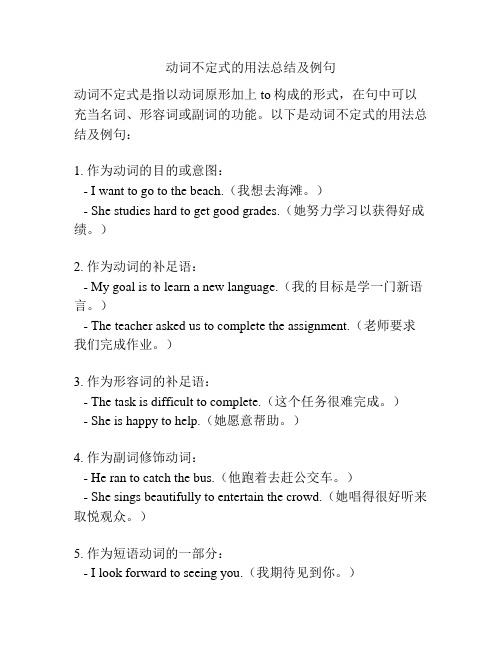
动词不定式的用法总结及例句动词不定式是指以动词原形加上to构成的形式,在句中可以充当名词、形容词或副词的功能。
以下是动词不定式的用法总结及例句:1. 作为动词的目的或意图:- I want to go to the beach.(我想去海滩。
)- She studies hard to get good grades.(她努力学习以获得好成绩。
)2. 作为动词的补足语:- My goal is to learn a new language.(我的目标是学一门新语言。
)- The teacher asked us to complete the assignment.(老师要求我们完成作业。
)3. 作为形容词的补足语:- The task is difficult to complete.(这个任务很难完成。
)- She is happy to help.(她愿意帮助。
)4. 作为副词修饰动词:- He ran to catch the bus.(他跑着去赶公交车。
)- She sings beautifully to entertain the crowd.(她唱得很好听来取悦观众。
)5. 作为短语动词的一部分:- I look forward to seeing you.(我期待见到你。
)- He decided to give up smoking.(他决定戒烟。
)6. 作为动词的主语:- To live a healthy lifestyle is important.(过健康的生活方式很重要。
)- To travel the world is his dream.(环游世界是他的梦想。
)7. 作为动词的宾语:- I like to read novels.(我喜欢读小说。
)- They want to visit their grandparents.(他们想去拜访祖父母。
)需要注意的是,动词不定式在句中的位置可以灵活变化,但通常放在动词之后、名词之前、或者作为句子的结尾。
常见动词不定式词组、句型用法总结
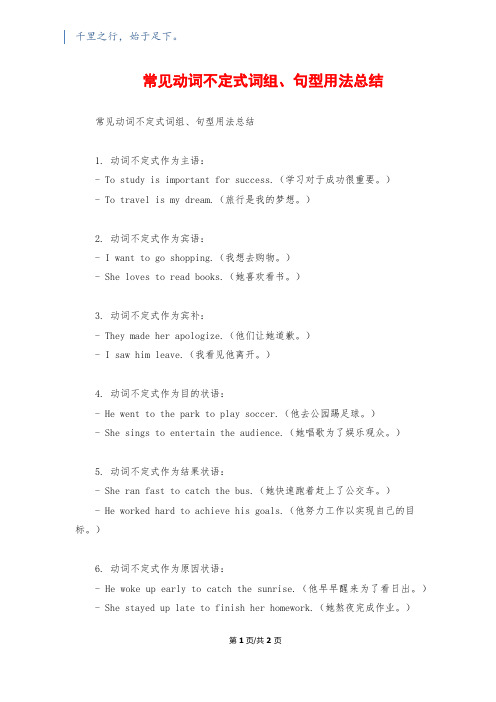
千里之行,始于足下。
常见动词不定式词组、句型用法总结常见动词不定式词组、句型用法总结1. 动词不定式作为主语:- To study is important for success.(学习对于成功很重要。
)- To travel is my dream.(旅行是我的梦想。
)2. 动词不定式作为宾语:- I want to go shopping.(我想去购物。
)- She loves to read books.(她喜欢看书。
)3. 动词不定式作为宾补:- They made her apologize.(他们让她道歉。
)- I saw him leave.(我看见他离开。
)4. 动词不定式作为目的状语:- He went to the park to play soccer.(他去公园踢足球。
)- She sings to entertain the audience.(她唱歌为了娱乐观众。
)5. 动词不定式作为结果状语:- She ran fast to catch the bus.(她快速跑着赶上了公交车。
)- He worked hard to achieve his goals.(他努力工作以实现自己的目标。
)6. 动词不定式作为原因状语:- He woke up early to catch the sunrise.(他早早醒来为了看日出。
)- She stayed up late to finish her homework.(她熬夜完成作业。
)第1页/共2页锲而不舍,金石可镂。
7. 动词不定式作为条件状语:- If you want to succeed, you must work hard.(如果你想成功,你必须努力。
)- You have to practice every day to improve your English.(你必须每天练习才能提高英语。
)8. 动词不定式作为伴随状语:- She listened to music to relax.(她听音乐放松。
动词不定式的用法总结
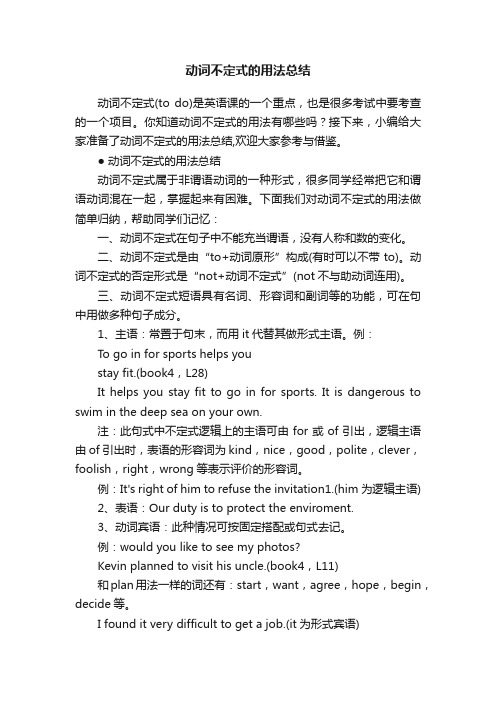
动词不定式的用法总结动词不定式(to do)是英语课的一个重点,也是很多考试中要考查的一个项目。
你知道动词不定式的用法有哪些吗?接下来,小编给大家准备了动词不定式的用法总结,欢迎大家参考与借鉴。
●动词不定式的用法总结动词不定式属于非谓语动词的一种形式,很多同学经常把它和谓语动词混在一起,掌握起来有困难。
下面我们对动词不定式的用法做简单归纳,帮助同学们记忆:一、动词不定式在句子中不能充当谓语,没有人称和数的变化。
二、动词不定式是由“to+动词原形”构成(有时可以不带to)。
动词不定式的否定形式是“not+动词不定式”(not不与助动词连用)。
三、动词不定式短语具有名词、形容词和副词等的功能,可在句中用做多种句子成分。
1、主语:常置于句末,而用it代替其做形式主语。
例:To go in for sports helps youstay fit.(book4,L28)It helps you stay fit to go in for sports. It is dangerous to swim in the deep sea on your own.注:此句式中不定式逻辑上的主语可由for或of引出,逻辑主语由of引出时,表语的形容词为kind,nice,good,polite,clever,foolish,right,wrong等表示评价的形容词。
例:It's right of him to refuse the invitation1.(him为逻辑主语)2、表语:Our duty is to protect the enviroment.3、动词宾语:此种情况可按固定搭配或句式去记。
例:would you like to see my photos?Kevin planned to visit his uncle.(book4,L11)和plan用法一样的词还有:start,want,agree,hope,begin,decide等。
动词不定式6种用法
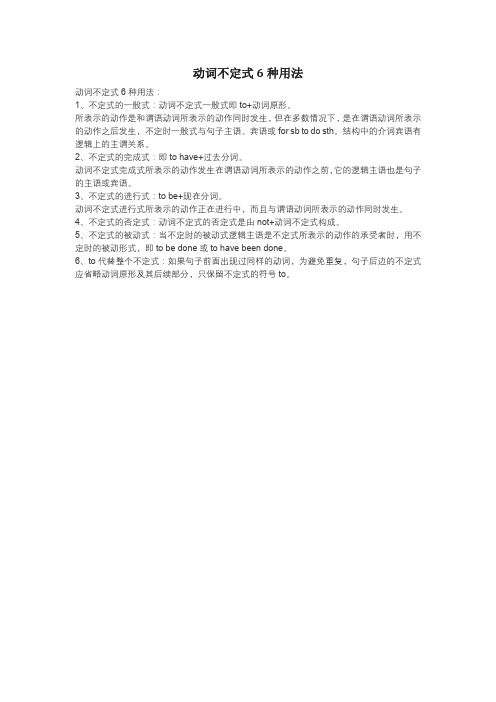
动词不定式6种用法
动词不定式6种用法:
1、不定式的一般式:动词不定式一般式即to+动词原形。
所表示的动作是和谓语动词所表示的动作同时发生,但在多数情况下,是在谓语动词所表示的动作之后发生,不定时一般式与句子主语、宾语或for sb to do sth。
结构中的介词宾语有逻辑上的主谓关系。
2、不定式的完成式:即to have+过去分词。
动词不定式完成式所表示的动作发生在谓语动词所表示的动作之前,它的逻辑主语也是句子的主语或宾语。
3、不定式的进行式:to be+现在分词。
动词不定式进行式所表示的动作正在进行中,而且与谓语动词所表示的动作同时发生。
4、不定式的否定式:动词不定式的否定式是由not+动词不定式构成。
5、不定式的被动式:当不定时的被动式逻辑主语是不定式所表示的动作的承受者时,用不定时的被动形式,即to be done或to have been done。
6、to代替整个不定式:如果句子前面出现过同样的动词,为避免重复,句子后边的不定式应省略动词原形及其后续部分,只保留不定式的符号to。
动词不定式的基本用法归纳经典实用

•动词不定式的基本用法归纳
此课件下载可自行编辑修改,供参考! 感谢你的支持,我们会努力做得更好!
All I want to do now (What I want to do now) is fill
my stomach.
•动词不定式的基本用法归纳
4.作宾语补足语
【注意】在感官动词(see, hear, feel, listen to , notice, watch, observe等)和使役动词(let, have, make )后的补足语中,不定式不带to。但这类 句子变成被动语态时,必须带to。
有时置于句中或句未,须状语常用如下句型
Too + 形容词/副词 + to do sth 名词/ 形容词/副词 + enough + to do sth enough+名词 +to do sth such +(形容词)名词 +as to do sth so + 形容词/副词 + as to do sth 【注意】不定式作状语,其逻辑主语与句子的
5.定语
1、不定式与被修饰的名词往往构成逻辑上的关系。 如名词为不定式的逻辑主语,构成主谓关系; 若名 词为逻辑宾语,则构成动宾关系;
He is not a man to tell lies.
There will not be enough space to stand in on the earth 2、作定语的不定式与所修饰的名词之间是动宾关系, 不定式动词又是不及物动词时,应在该动词上加上 一个介词,如;
(2)To master English gives us much help in the study of sience. B. 不定式或不定式短语作主语时,常用it作形 式主语,构成“It is + 形容词(+for sb.)不定式” 结构。
动词不定式用法小结
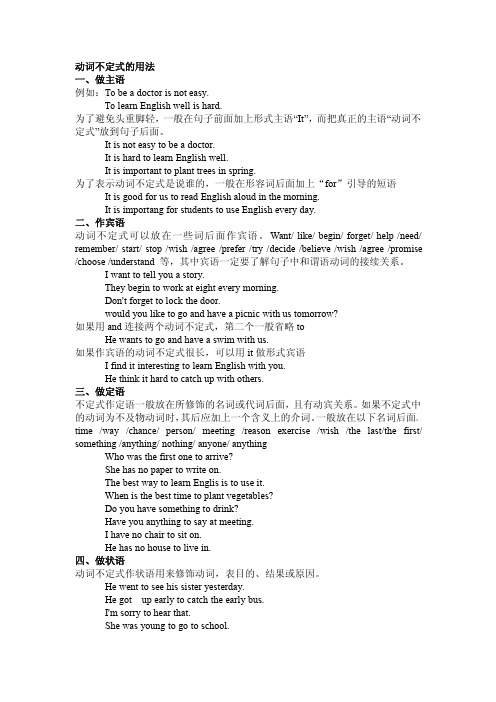
动词不定式的用法一、做主语例如:To be a doctor is not easy.To learn English well is hard.为了避免头重脚轻,一般在句子前面加上形式主语“It”,而把真正的主语“动词不定式”放到句子后面。
It is not easy to be a doctor.It is hard to learn English well.It is important to plant trees in spring.为了表示动词不定式是说谁的,一般在形容词后面加上“for”引导的短语It is good for us to read English aloud in the morning.It is importang for students to use English every day.二、作宾语动词不定式可以放在一些词后面作宾语。
Want/like/begin/forget/help/need/ remember/start/stop/wish/agree/prefer/try/decide/believe/wish/agree/promise /choose/understand等,其中宾语一定要了解句子中和谓语动词的接续关系。
I want to tell you a story.They begin to work at eight every morning.Don't forget to lock the door.would you like to go and have a picnic with us tomorrow?如果用and连接两个动词不定式,第二个一般省略toHe wants to go and have a swim with us.如果作宾语的动词不定式很长,可以用it做形式宾语I find it interesting to learn English with you.He think it hard to catch up with others.三、做定语不定式作定语一般放在所修饰的名词或代词后面,且有动宾关系。
动词不定式的用法总结

动词不定式的用法总结
1.作为句子的主语:
Ex: To study English is important for success.
2.作为句子的宾语:
Ex: I want to learn how to play the guitar.
3.作为动词的宾语补语:
Ex: She found it difficult to understand the instructions.
4.与一些动词连用,构成特定的动词短语:
Ex: I need to go to the store.
He wants to buy a car.
5.作为目的状语,表示动作的目的或意图:
Ex: He went to the library to study.
6.作为结果状语,表示结果或后果:
Ex: She studied hard to pass the exam.
7.作为方式状语,表示动作的方式或方法:
Ex: He walked slowly to avoid falling.
8.与形容词连用,表示主语的特征或状态:
Ex: She is happy to see her friends.
9.与副词连用,表示副词的程度或程度的变化:
Ex: He tried to be more careful.。
(完整版)动词不定式用法归纳
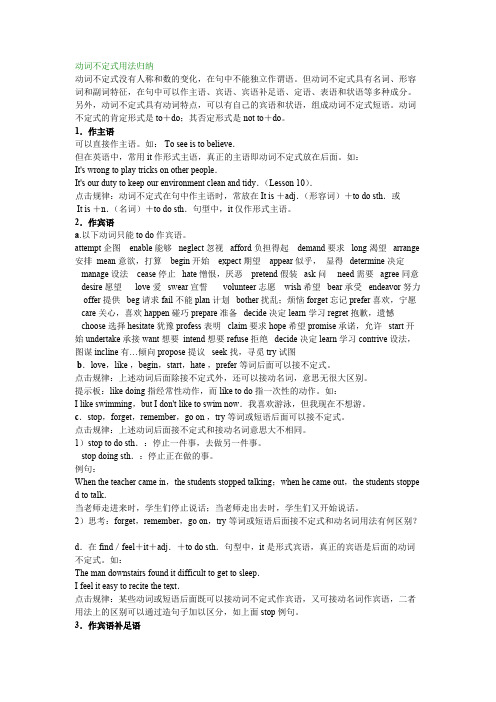
动词不定式用法归纳动词不定式没有人称和数的变化,在句中不能独立作谓语。
但动词不定式具有名词、形容词和副词特征,在句中可以作主语、宾语、宾语补足语、定语、表语和状语等多种成分。
另外,动词不定式具有动词特点,可以有自己的宾语和状语,组成动词不定式短语。
动词不定式的肯定形式是to+do;其否定形式是not to+do。
1.作主语可以直接作主语。
如: To see is to believe.但在英语中,常用it作形式主语,真正的主语即动词不定式放在后面。
如:It's wrong to play tricks on other people.It's our duty to keep our environment clean and tidy.(Lesson 10).点击规律:动词不定式在句中作主语时,常放在It is +adj.(形容词)+to do sth.或It is +n.(名词)+to do sth.句型中,it仅作形式主语。
2.作宾语a.以下动词只能to do 作宾语。
attempt企图 enable能够 neglect忽视 afford负担得起 demand要求 long渴望 arrange 安排 mean意欲,打算 begin开始 expect期望 appear似乎,显得 determine决定manage设法 cease停止 hate憎恨,厌恶 pretend假装 ask问 need需要 agree同意 desire愿望 love爱 swear宣誓 volunteer志愿 wish希望 bear承受 endeavor努力 offer提供 beg请求 fail不能 plan计划 bother扰乱;烦恼 forget忘记 prefer喜欢,宁愿 care关心,喜欢 happen碰巧 prepare准备 decide决定 learn学习 regret抱歉,遗憾choose选择 hesitate犹豫 profess表明 claim要求 hope希望 promise承诺,允许 start开始 undertake承接 want想要 intend想要 refuse拒绝 decide决定 learn学习 contrive设法,图谋 incline有…倾向 propose提议 seek找,寻觅 try试图b.love,like ,begin,start,hate ,prefer等词后面可以接不定式。
动词不定式的用法归纳

动词不定式的用法归纳以下是 8 条关于动词不定式的用法归纳:1. 哎呀呀,动词不定式可以用来作主语呢!就像“To learn a new language is a great challenge.(学习一门新语言是一个巨大的挑战。
)”,这不是很直白嘛!2. 嘿,它还能作宾语呢!比如说“I want to go shopping.(我想去购物。
)”,多简单易懂呀!3. 哇塞,作宾语补足语也是常有的事儿呀!像“He asked me to help him.(他叫我去帮助他。
)”,是不是一下子就明白啦?4. 你瞧,还可以作定语呢!像“There is nothing to worry about.(没什么可担心的。
)”,这不是挺清楚的嘛!5. 哎呀,作状语也没问题呀!比如“In order to catch the early bus, Igot up very early.(为了赶上早班车,我起得很早。
)”,这多好理解呀!6. 嘿,没想到吧,还能作表语呢!“My dream is to be a doctor.(我的梦想是成为一名医生。
)”,是不是很形象?7. 哇,和疑问词连用也超级棒呢!就像“How to solve the problem is very important.(如何解决这个问题非常重要。
)”,这多有意思!8. 最后呀,动词不定式还能有一些特殊用法呢!比如“had better do sth.(最好做某事)”,像“You'd better go to bed early.(你最好早点睡觉。
)”。
总之,动词不定式的用法可真是多种多样呀,大家可要好好掌握哦!。
动词的不定式用法

动词的不定式用法
1. 嘿,你知道吗,动词不定式可以用来表示目的呀!就像“我去超市买东西”,这里的“买东西”就是动词不定式,表明我去超市的目的呢。
2. 哇塞,动词不定式还能用来作宾语补足语呀!比如“妈妈让我去洗手”,“去洗手”这不定式就是补充说明“我”要做的事情,这不是很神奇吗!
3. 哎呀呀,当你想要表达一种未发生的事情时,也可以用动词不定式呢!像“明天我要去看电影”就是典型的例子呀,还不有趣?
4. 嘿,动词不定式也能在一些固定短语里出现呢!“have nothing to do”,这不就是嘛,简单明了。
5. 哇哦,你想想看,“想要做某事”,这里面就有动词不定式呀,它就是这样无处不在呢!
6. 哟呵,有时候描述一个人的能力也能用动词不定式呀,“他能跑得很快”,“跑得很快”就是不定式,多有意思呀!
7. 哈哈,动词不定式还可以用来表达原因呢!就好像“他很高兴去参加聚会”,“去参加聚会”就是他高兴的原因呢!
总之,动词不定式的用法真是丰富多彩呀,我们在日常交流和写作中可少不了它呢!。
动词不定式的语法总结

动词不定式的语法总结动词不定式是非谓语动词的一种形式,是英语中常见的一种语法,学生一定要做好总结,拿下这个知识点。
小编为大家力荐了动词不定式常用的语法总结,给大家作为参考,欢迎阅读!动词不定式的七种用法动词不定式的基本形式为to+动词原形.1.动词不定式做主语.谓语用第三人称单数形式.如果主语较长则用it做形式主语,将真正的主语动词不定式放到句尾.egTo see is to believe.It's a bad habit to run after dinner.2 做表语.the important things is to save lives.3 做宾语he likes to play with children.4做宾语补足语.形容词做宾补时.常用it做形式宾语.把真正的宾语放到宾补之后.he feels it happy to help others.5做定语she asked me to help her with her English.6做状语you are never too old to learn.(结果状语)7特殊疑问词+动词不定式.I am thinking about what to say.动词的不定式的用法口诀①不定式有标记,to与动词连一起。
②没有人称数变化,动词特点它具备。
③主宾定状表补语,唯独作谓不可以。
④not 加上不定式,否定结构要牢记。
⑤疑问词与不定式,构成短语有意义。
⑥仔细推敲多思考,准确判断有依据。
动词不定式专题练习1. This company was the first ____ portable radios as well as cassette tape recorders in the world.A. producingB. to produceC. having producedD. produced2. The purpose of new technology is to make life easier, ____it more difficult.A .not making B. not make C .not to make D. nor to make3. Helen had to shout ______above the sound of the music .A .making herself hear B. to make herself hearC. making herself heard D .to make herself heard4. I don’t know whether you happen_______ ,but I am going to study in the U.S.A this September.A .to be heard. B. to be bearing C .to hear D .to have heard5. The news reporters hurried to the airport, only ______the film stars had left.A .to tellB .to be toldC .tellingD .told6. You were silly not _______your car.A. to lockB. to have lockedC. lockingD. having locked7. The teacher asked us ______so much noise.A .don’t make B. not make C. not making D .not to make8. An army spokesman stressed that all the soldiers had been ordered _____clear warnings before firing any shots.A .to issue B. being issued C. to have issued D. to be issued9. I’d rather have a room of my own, however small it is, than_______ a room with someone else.A. to shareB. to have sharedC. shareD. sharing10. The bank is reported in the local newspaper_________ in broad daylight yesterday.A. robbedB. to have been robbedC. being robbedD. having been robbed11. A number of paintings in the castle are believed ________ina fire.A. being destroyedB. having been destroyedC. to be destroyedD. to have been destroyed12. The meeting _______ next week is sure to be a great success.A. to take placeB. to be taken placeC. to have taken placeD. being taken place13. As a result of my laziness, I failed ________ my work in time.A. and finishedB. to finishC. and finishingD. to finished14. I am sorry ______ written you a letter at the time.A. to have notB. to not haveC. not to haveD. not having15. Will you lend him a magazine _________?A. to be readB. for readingC. to readD. he read16. He could do nothing but _______for the bus _________.A. wait, to comeB. wait; comeC. waiting; comingD. waited; came17 .It is a problem that doesn't need ________ right now.A. to solveB. solvingC. being solvedD. to be solving18. There’s a man at the reception desk who seems very angry and I think he means _______ trouble.A. makingB. to makeC. to have madeD. having made19. I remember _______him _______the bike needed __________.A. hearing, saying, to repairB. to hear, say, to repairC. hearing, say, repairingD. to hear, saying, to be repaired20. --- You should have thanked her before you left.--- I meant _________, but when I was leaving I couldn’t find her anywhere.。
动词不定式6种用法总结
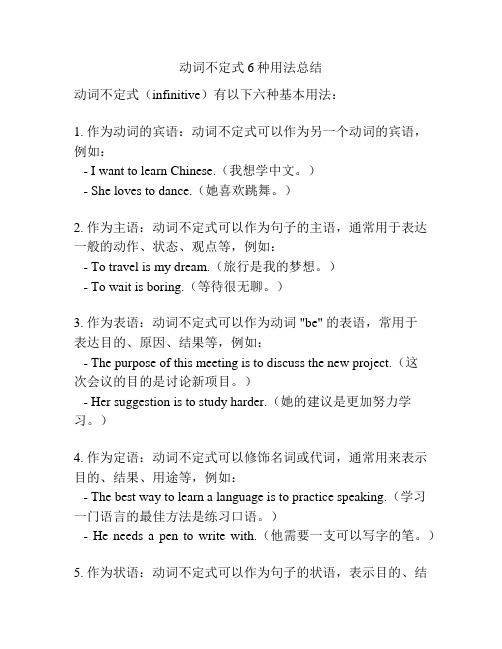
动词不定式6种用法总结动词不定式(infinitive)有以下六种基本用法:1. 作为动词的宾语:动词不定式可以作为另一个动词的宾语,例如:- I want to learn Chinese.(我想学中文。
)- She loves to dance.(她喜欢跳舞。
)2. 作为主语:动词不定式可以作为句子的主语,通常用于表达一般的动作、状态、观点等,例如:- To travel is my dream.(旅行是我的梦想。
)- To wait is boring.(等待很无聊。
)3. 作为表语:动词不定式可以作为动词 "be" 的表语,常用于表达目的、原因、结果等,例如:- The purpose of this meeting is to discuss the new project.(这次会议的目的是讨论新项目。
)- Her suggestion is to study harder.(她的建议是更加努力学习。
)4. 作为定语:动词不定式可以修饰名词或代词,通常用来表示目的、结果、用途等,例如:- The best way to learn a language is to practice speaking.(学习一门语言的最佳方法是练习口语。
)- He needs a pen to write with.(他需要一支可以写字的笔。
)5. 作为状语:动词不定式可以作为句子的状语,表示目的、结果、方式、条件等,常常与动词 "to be" 连用,例如:- She went to the supermarket to buy some groceries.(她去超市买些食品杂货。
)- He ran fast to catch the bus.(他跑得很快,以便赶上公交车。
)6. 作为补语:动词不定式可以作为某些动词的宾语补足语,常用于表示目的、愿望、需求等,例如:- They made her promise to come back.(他们让她答应会回来。
动词不定式的用法大全

动词不定式的用法大全今天一起学习动词不定式的用法大全?快来一起学习吧。
下面就和大家分享,来欣赏一下吧。
动词不定式的用法大全一、动词不定式是什么?简单来说:to do,非谓语动词形式之一二、位置?须位于被其修饰的名词或代词之后如:Is this the best way to help him?三、作用?具有名词,形容词,和副词的作用四、在句中可做的成分?除了不可做谓语外,其他成分都可以充当如:主语,宾语,定语,表语,宾补,状语(目的,结果,原因)例句:1.To see is tobelieve.眼见为实/百闻不如一见。
(做主语)2. I wish to be sentto work in the country. (做宾语)3. Can you tell me which is the car to be repaired (做定语)4. My work is to clean the room every day. (做表语)5. He went to the hospital to be examined . (做目的状语)6. I don’t think it rightto do it that way. (做宾补)注意:英语中为了避免头重脚轻(说白了就是平衡句子结构的需要),往往to do一般用it作形式主语(It+be+形容词/名词词组+to do sth/ that)如:To help each other is good. =It is good to help each other .这句话的主语是老师标紫色的字体。
五、不定式的用法1.不定式常可用来修饰人也可以修饰物,表示已经将要发生的动作。
如:(1)He was the first guest to arrive. 他是第一个到达的客人。
(2)He was a brave man to do what he did.他是个勇者才有这样的行为。
动词不定式用法大全

动词不定式用法大全
1. 作为动词的宾语:I want to go (我想去)。
2. 作为动词的补语:He seems to know the answer (他似乎知道答案)。
3. 作为目的状语:He went to the store to buy some groceries (他去商店买些杂货)。
4. 作为原因状语:I stayed home to finish my homework (我呆在家里完成我的家庭作业)。
5. 作为结果状语:He ran fast to catch the bus (他跑得快以赶上公共汽车)。
6. 用于被动语态:I hope to be invited to the party (我希望被邀请参加晚会)。
7. 用于虚拟语气:If I were you, I would study harder (如果我是你,我会更加努力学习)。
8. 用于感叹句:What a wonderful place to visit! (真是一个美妙的地方可供参观)
此外,动词不定式还可以有时态和语态的变化,如:to be + 动词的不定式形式。
在句子中,动词不定式通常是以 "to" 作为引导词,但有时也可以省略 "to",具体取决于动词或动词短语的前后关系。
需要注意的是,动词不定式一般不具有时态和人称的变化,常用的形式为:to + 动词原形。
总之,动词不定式在句子中具有多种用法,可以根据句子的结构和意义来确定具体的用法。
动词不定式的用法
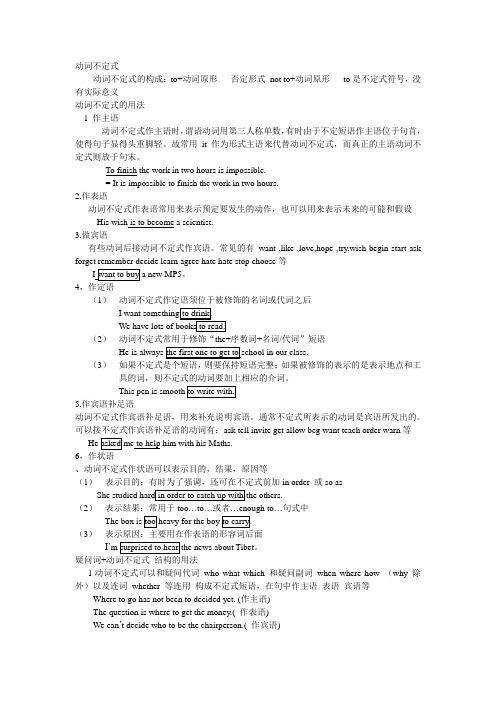
动词不定式动词不定式的构成:to+动词原形否定形式not to+动词原形to是不定式符号,没有实际意义动词不定式的用法1 作主语动词不定式作主语时,谓语动词用第三人称单数,有时由于不定短语作主语位于句首,使得句子显得头重脚轻。
故常用it作为形式主语来代替动词不定式,而真正的主语动词不定式则放于句末。
To finish the work in two hours is impossible.= It is impossible to finish the work in two hours.2.作表语动词不定式作表语常用来表示预定要发生的动作,也可以用来表示未来的可能和假设His wish is to become a scientist.3.做宾语有些动词后接动词不定式作宾语。
常见的有want ,like ,love,hope ,try,wish begin start ask forget remember decide learn agree hate hate stop choose等。
4,作定语(1)动词不定式作定语须位于被修饰的名词或代词之后(2)动词不定式常用于修饰“the+序数词+名词/代词”短语(3)如果不定式是个短语,则要保持短语完整;如果被修饰的表示的是表示地点和工具的词,则不定式的动词要加上相应的介词。
5.作宾语补足语动词不定式作宾语补足语,用来补充说明宾语。
通常不定式所表示的动词是宾语所发出的。
可以接不定式作宾语补足语的动词有:ask tell invite get allow beg want teach order warn等He asked me to help him with his Maths.6,作状语、动词不定式作状语可以表示目的,结果,原因等(1)表示目的:有时为了强调,还可在不定式前加in order 或so as(2)表示结果:常用于too…to…或者…enough to…句式中(3)表示原因:主要用在作表语的形容词后面I’。
- 1、下载文档前请自行甄别文档内容的完整性,平台不提供额外的编辑、内容补充、找答案等附加服务。
- 2、"仅部分预览"的文档,不可在线预览部分如存在完整性等问题,可反馈申请退款(可完整预览的文档不适用该条件!)。
- 3、如文档侵犯您的权益,请联系客服反馈,我们会尽快为您处理(人工客服工作时间:9:00-18:30)。
动词不定式不定式定义:由to+动词原形构成。
不定式是一种非限定性动词。
而非限定动词是指那些在句中不能单独充当谓语的动词,可分为不定式,动名词,现在分词和过去分词。
“动词不定式”由动词+不定式构成。
动词不定式在句中可以作句子除谓语之外的任何句子成分。
动词不定式的被动形式除了一般形式外还有其完成式和进行式。
目录时态、语态介绍(1)语态(2)时态疑问词+不定式结构语法功能一、作主语二、作宾语三、作补语四、作表语五、作状语介词六、作定语省to的动词不定式介绍典型例题否定式not to do..特殊句型不定式与介词"to"区别与动名词区别与联系与动名词语义不同目录1 forget doing/to do2 stop doing/to do3 remember doing/to do4 regret doing/to do5 cease doing/to do6 try doing/to do7 go on doing/to do8 be afraid doing/to do9 be interested doing/to do10 mean to doing/to do11 begin(start) doing/to do被动式的用法一、不定式被动式的用法二、不定式完成被动式的用法完成式的用法一、表示发生在谓语动作之前的动作二、表示在某个给定的时间之前已完成的动作三、表示过去未曾实现的想法和愿望在There be句型中用法时态、语态介绍(1)语态(2)时态疑问词+不定式结构语法功能一、作主语二、作宾语三、作补语四、作表语五、作状语介词六、作定语省to的动词不定式介绍典型例题否定式not to do..特殊句型不定式与介词"to"区别与动名词区别与联系与动名词语义不同目录1 forget doing/to do2 stop doing/to do3 remember doing/to do4 regret doing/to do5 cease doing/to do6 try doing/to do7 go on doing/to do8 be afraid doing/to do9 be interested doing/to do10 mean to doing/to do11 begin(start) doing/to do被动式的用法一、不定式被动式的用法二、不定式完成被动式的用法完成式的用法一、表示发生在谓语动作之前的动作二、表示在某个给定的时间之前已完成的动作三、表示过去未曾实现的想法和愿望在There be句型中用法展开编辑本段时态、语态介绍动词不定式可以作以上各种成分,但它毕竟是动词,所以有动词的属性。
动词不定式及其短语还可以有自己的宾语、状语,虽然动词不定式在语法上没有表面上的直接主语,但它表达的意义是动作,这一动作一定由使动者发出。
这一使动者我们称之为逻辑主语,其形式如下:(1)语态如果动词不定式的逻辑主语是这个不定式所表示的动作的承受者,不定式一般要用被动语态形式。
如:It's a great honour to be invited to Mary's birthday party.(不定式作主语是被动语态to be invited是被邀请)It was impossible for lost time to be made up.(不定式作主语)I wish to be sent to work in the country.(不定式作宾语)Can you tell me which is the car to be repaired?(不定式作定语)He went to the hospital to be examined.(不定式作状语)在There be结构中,修饰主语的不定式可用被动,也可用主动。
如:There are still many things to take care of (to be taken care of).但有时两种形式表达的意思不同,如:These is nothing to do now.( We have nothing to do now.) There is nothing to be done now.(We can do nothing now.)(2)时态1) 现在时:一般现在时表示的动词,有时与谓语动词表示的动作同时发生,有时发生在谓语动词的动作之后。
He seems to know this.I hope to see you again. = I hope that I'll see you again.我希望再见到你。
2) 完成时:表示的动作发生在谓语动词表示的动作之前。
I'm sorry to have given you so much trouble.He seems to have caught a cold.3) 进行时:表示动作正在进行,与谓语动词表示的动作同时发生。
He seems to be eating something.4) 完成进行时:She is known to have been wreaking on the problem for many years.一般在情绪后加to do to do 也表将来编辑本段疑问词+不定式结构疑问词who,what,which,when,where,whether,how后可接不定式构成不定式短语,在句中作主语、宾语、表语等。
如:①When to leave for London has not been decided yet. (不定式在句子中做主语)②Mr. Smith didn't know whether to leave or stay there. (不定式在句子中做宾语)③I asked Professor Xu how to learn English well. (不定式在句子中做直接宾语)④The question was where to get the medicine needed. (不定式在句子中表语)以上例句中疑问词+不定式部分,均可转换为相应的从句形式。
如:①When we shall leave…③…how Icould learn…经常在这种结构中使用的动词有:consider,decide,discover,explain,find out,forget,hear,know,lea rn,observe,understand,wonder等。
编辑本段语法功能一、作主语动词不定式作主语时,句子的谓语动词常用单数,其位置有以下两种:(1)把不定式置于句首。
如:To get there by bike will take us half an hour.(2)用it作形式主语,把真正的主语不定式置于句后,常用于下列句式中。
如:①It+be+名词+to doIt's our duty to take good care of the old.②It takes sb+some time+to doHow long did it take you to finish the work?③It+be+形容词+for sb+to doIt is difficult for us to finish writing the composition in a quarter of an hour.④It+be+形容词+of sb+to doIt is stupid of you to write down everything (that) the teacher says.⑤It seems(appears)+形容词+to doIt seemed impossible to save money.在句型③中,常用表示客观情况的形容词,如:difficult,easy,hard,important,impossible,necessary 等;在句型④中,常用careless,clever,good,foolish,honest,kind,lazy,nice,right,silly,stupid,wise等表示赞扬或批评的词。
在不定式前的sb,可看作其逻辑主语。
这一句式有时相当于Sb is+形容词+to do句式,如:It's kind of you to help me with my English.=Y ou are kind to helpme with my English.(3)举例(1)It's easy (for me) to do that.我做这事太容易了easy,difficult,hard,important,possible,impossible,comfortable,necessary, better;the first,the next,the last,the best,too much,too little,not enoughIt's so nice to hear your voice.听到你的声音真高兴。
It's necessary for you to lock the car when you do not use it.当你不用车的时候,锁车是有必要的。
(2)It's very kind of him to help us.他帮助我们,他真好。
Kind,nice,stupid,rude,clever,foolish,thoughtful,thoughtless,brave, considerate(考虑周到的),silly,selfish(自私的)例句:It was silly of us to believe him.我们真愚蠢,竟然相信了他。
It seemed selfish of him not to give them anything.他不给他们任何东西,这显得太自私了。
注意:(1)其他系动词如,look,appear等也可用于此句型(2)不定式作为句子成分时,动词用单数形式。
(3)当不定式作主语的句子中又有一个不定式作表语时,不能用It is… to…的句型(对)To see is to believe.眼见为实。
(错)It is to believe to see.二、作宾语1) 以下动词后,只能跟不定式作宾语afford (付得起),agree(同意),aim(力求做到),appear(显得),arrange(安排),ask (要求),attempt (试图),care(想要),choose(决定),claim(声称),condescend(屈尊),consent(准许),decide(决定),demand(要求),determine(决心),endeavor(竭力),expect(期待),fail(未履行),help(帮助),hesitate(犹豫),hope(希望),learn(学会),manage(设法),neglect(疏忽),offer(主动提出),plan(计划),prepare(准备),pretend (假装),proceed(接着做),promise(答应),prove(证明),refuse(拒绝),resolve(解决),seem(觉得好像),swear(发誓),tend(往往会),threaten(预示),undertake(承诺),volunteer(自愿做),vow(发誓),want(想要),wish(希望)举例:The driver failed to see the other car in time.司机没能及时看见另一辆车。
